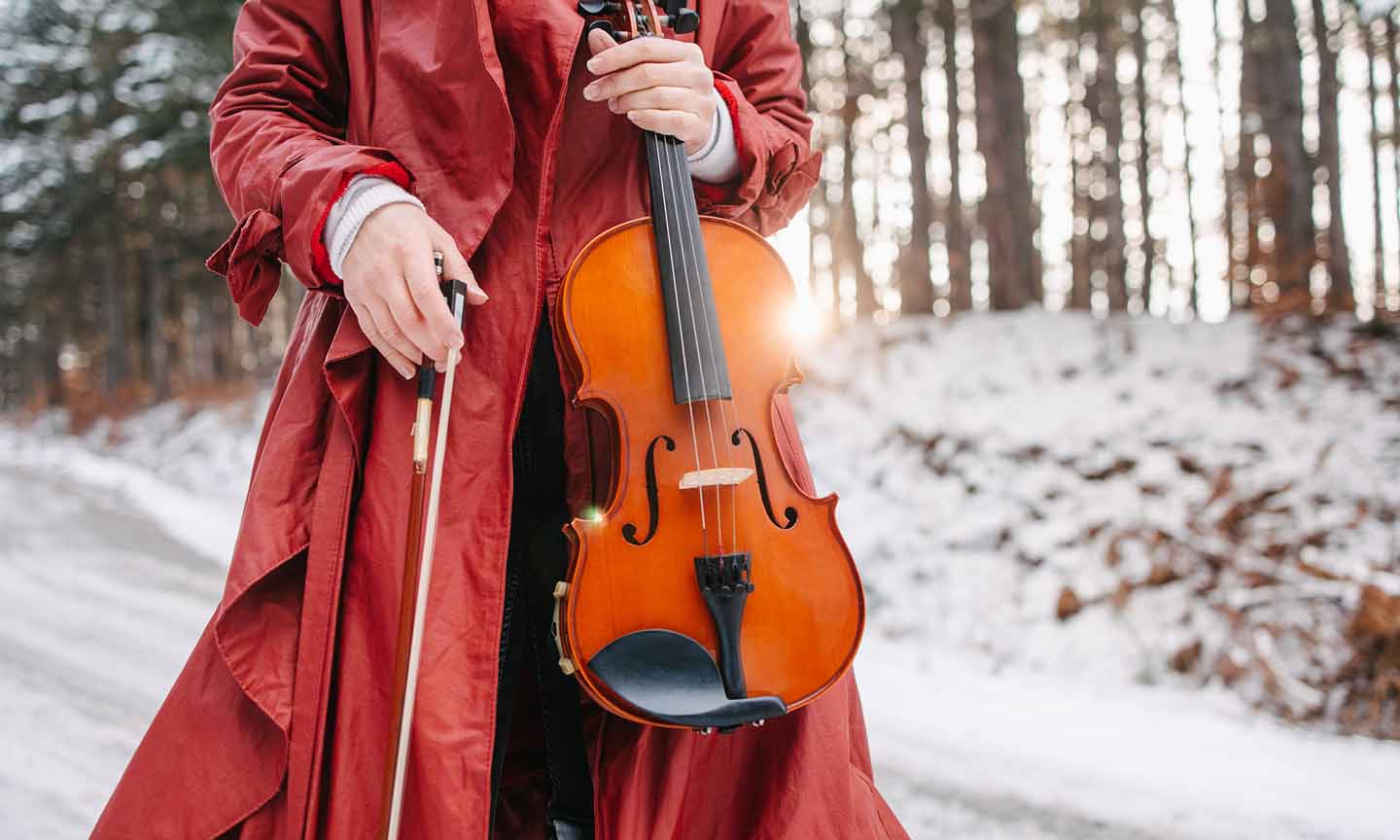The natural world offers artistic inspiration in abundance. Winter, in particular, has an austere beauty, one that juxtaposes hard, frozen landscapes with the softness of snow; the cold ice of frost with the warmth of nostalgia; and the sadness of natural endings with the comfort of retrospection and remembrance. For all its beauty and allegorical symbolism, musical interpretations of falling snow and frozen landscapes are ever-present in the classical repertoire. So as the trees lose their leaves, the nights draw in, and we start to look back over the year that was, it’s time to get cozy with these wintry classics. Scroll down to discover our selection of the best classical music for winter, featuring our favorite frostiest musical masterpieces.
10. Debussy: The Snow is Dancing (Children’s Corner)
Debussy’s “The Snow is Dancing” is one of the best pieces of classical music for winter. This piano miniature is thoroughly deserving of its wonderfully evocative title: a twinkling flurry of unrelenting staccato notes cascade down the keyboard, whilst light, delicate melodies emerge from the hazy mist of semiquavers. Not only does Debussy give us exquisite musical imagery, the Children’s Corner suite was originally dedicated to Debussy’s daughter Claude-Emma and radiates childlike innocence, playfulness, and a warm sense of nostalgia.
9. Rimsky-Korsakov: The Snow Maiden Suite
Next up is Rimsky-Korsakov’s opera The Snow Maiden, another snowy showstopper. This work is steeped in Russian musical tradition. The libretto is based on a pantheistic folk tale, where the metamorphosis of winter into spring is a metaphor for the reconciliation of the protagonists, the Snow Maiden and her lover, Mizgir. Rimsky-Korsakov’s widespread use of folksong throughout the score emphasizes the connection to nature: the suite opens with a wintry scene-setter of fluttering strings and icy woodwind, before moving into the rustic and spritely “Dance of the Birds.”
8. Cage: Winter Music
Ever the innovator, Cage’s Winter Music is not really a score, but rather a set of 20 separate pages of music that can be played by up to 20 different pianists. Some, all, or any of the pages can be used, in any order. Confused? Yes, us too. But that’s the magic of Cage – hidden in the seemingly random pages and the jumble of contrasting piano textures, rhythms, and pitches, is a beautiful ode to winter. Sometimes the landscape is harsh, jagged, icy, and slippery underfoot but at other times, it’s soft, delicate, and tranquil. It’s the free, improvised, unpredictable mood of this piece that makes it the perfect musical characterization of winter.
7. Korngold: Der Schneemann
Der Schneemann (“The Snowman”), one of the best pieces of classical music for winter, is a ballet-pantomime and one of Korngold’s earliest works, written when he was merely 11 years old. Originally composed for piano, the ballet was such as success at its 1910 premiere in Vienna that it was later developed into the orchestral version we know today. The story is based on a commedia dell’arte scenario that his father had written, with stock character Pierrot disguising himself as a snowman in order to run away with the lovely Columbine without her uncle Pantalon’s knowledge. Korngold’s score exemplifies his wonderful late-romantic, post-Wagnerian compositional style, and exudes character, wit, charm, and light-heartedness. A truly warming winter delight.
6. Chopin: Étude No. 11 in A minor, ‘Winter Wind’
Of Chopin’s 24 Etudes, No.11 in A minor is often considered the most fiendish. It’s perhaps better known by its moniker “Winter Wind,” and it’s easy to see why. Designed to develop the pianist’s technique and dexterity, this work is a relentless torrent of semiquaver-tuplets in the right hand, and an ominous chordal theme in the left. Designed to be performed at high speed, Chopin’s Étude is the perfect depiction of blizzarding snow, freezing cold, howling winds, and shattering ice. You might find it difficult to warm up after this one.
5. Glazunov: Winter (The Seasons)
The first tableau of Glazunov’s ballet, The Seasons, is titled “A Winter Landscape.” In musically depicting winter, Glazunov goes a step further, and the audience are actually presented with the living embodiment of Winter himself, who dances alongside his companions: Hoar-frost, Ice, Snow, and Hail. Each character is given their own variation of this snow-laden score. The anthropomorphizing of the winter weather is mirrored in the music, in a style not dissimilar to that of Tchaikovsky and indeed Glazunov’s teacher, Rimsky-Korsakov. With colorful instrumentation, including fluttering woodwind, trilling strings, magical harp flourishes, and warm-blooded romanticism a-plenty, Glazunov’s glorious ballet truly captures the beauty of winter.
4. Rutter: Blow, Blow, Thou Winter Wind
Although performed as a work in its own right, Blow Blow, Thou Winter Wind began life as part of Rutter’s choral cycle When Icicles Hang. It’s a magical setting of a song from the second act of Shakespeare’s As You Like It for SATB choir. This sweeping wintery piece begins with ominous, piercing harpsichord and the icy tone of the sopranos, but gradually thaws with grounding lower voices, with Rutter’s signature sweeping lyricism painting the words:
Heigh-ho! Sing heigh-ho! unto the green holly;
Most friendship is feigning, most loving mere folly:
Then heigh-ho, the holly! This life is most jolly.
3. Schubert: Winterreise
Schubert’s famous song cycle Winterreise, meaning “Winter Journey,” is the musical setting of 24 poems by Müller for tenor and piano. In this work, Schubert explores winter in its bleakest and rawest form: the singer wanders aimlessly (Gefrorne Tränen, meaning “Frozen Tears”), whilst dreaming of his love and of springtime (Frühlingstraum / “Dream of Spring”). He wakes, however, to the cold darkness of his wintery reality. From the stark, bare textures of opening song Gute Nacht (“Good Night”) to the static drone of the closing Der Leiermann (“The Herdy-Gerdy Man”), Schubert delicately balances words with music, galvanizing the text with exquisite melodies and romantic harmonies. This beautiful yet heart-wrenching tribute to love is one of the best pieces of classical music for winter.
2. Vaughan Williams: Sinfonia Antartica
Having been commissioned to score the 1947 movie Scott of the Antarctic, Vaughan Williams repurposed some of his material for his magnificent yet terrifying seventh symphony. Aptly titled Sinfonia Antartica, Vaughan Williams’ captures the epic, awesome power of the frozen landscape and paints perilous blizzards, overpowering icy winds, and ominous sense of the failed expedition. To capture the awesome power of the landscape Vaughan Williams uses huge orchestral forces, including wordless three-part female choir with soprano soloist as the icy winds in first and last movements, a twinkling celeste, harp, strings, organ (in the third movement), double woodwind, and an extended percussion section of glockenspiel, vibraphone, gong, bells, and even a wind machine. The fact that Vaughan Williams is able to imbue his score with the sheer vastness of the landscape, and the feeling of humanity paling into insignificance in comparison, is testament to his pure genius.
1. Vivaldi: Winter (The Four Seasons)
Vivaldi is surely the king of seasonal music. His glacial tribute to winter is the most dramatic of his Four Seasons. Dynamic and dangerous, the first movement is nothing short of iconic: pulsing, spikey strings and icy harpsichord accompany the famous, torrential violin solo, which requires technically demanding rapid string crossings, quick repeated notes, and ice-sharp precision. The third movement is somewhat bleaker, capturing the bleak, dark, and gloomy reality of winter nights. The brilliance of Vivaldi is his ability to capture so perfectly every aspect of winter in dramatic musical form.




